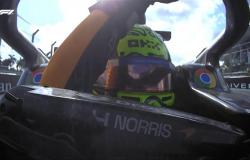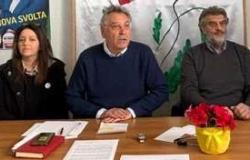
We were in the Aprilia Racing Department to discover, among other things, how the V4 used in MotoGP by Maverick Vinales and Aleix Espargarò is developed which, as is known (and in line with the other engines in the category) delivers power between the 270 and 300 horsepower for a red zone set at almost 20,000 rpm
LMotoGP has changed significantly in recent years, especially with aerodynamics and lowering systems, in a process that will only stop with the introduction of the new regulation scheduled for 2027. Yet, despite what people may think, motorcycle racing is still based on two solid pillars: the pilot and engine. In both cases MotoGP demands extreme results, values that do not exist in the real world. How much? We were in the Aprilia Racing Department and asked the men who work there, seeing up close how the MotoGP engines are built and tested, little technical monsters which, as we have known for a few seasons, they caress 20,000 rpm spitting out almost 300 HP. With us, in addition to Antonio Boselli who organized a series of visits exclusively for MOW, there are Walter Scattolin and Nicola Biliato. More than the numbers, what is striking is the sophistication offered by the machinery with which the engines are tested. And the fact that, passing in the corridor, those who work within the department are able to perfectly recognize the driving style of one or the other pilot by ear. To be clear: we are in what is called test room, the phone should be put in your pocket. No photos, because everything is extremely confidential. Indeed, if it were for them in some corners of the room – for example on the monitors with the data – we wouldn’t even have to look. “Here we do engine testing,” explains Nicola Biliato, who with Walter Scattolin (opening) manages this wing of development.
Dahead of us there is a room with an extremely refined test bench on which, like a trophy, a racing V4 is fixed. The room has a large window from which to control the movements of the motor surrounded by fans and instruments, while the various parameters of the bench are managed with push-button panels and joysticks. It looks like a movie. Nicola talks about the room speaking quickly: “This is where the engines that will go on the track are approved, they are validated before reaching the pilots both in terms of reliability – with correct assembly of the engine – and performance, which must be in line with expectations. Together with this, all the fine-tuning of the components is done here, so for example the fuel pump, the injectors, the variation of the airboxes, the exhaust valves… all the components that are used to make the engine work. Finally, here is the whole development part.”
QThis is one room, but judging by the long hallway outside you have several.
“We have different types of cells, or test rooms. There are static, dynamic and full dynamic ones, which means that they also replicate strategies such as anti-wheelie, anti-jerk, engine braking and traction control, while some cells simply reproduce the behavior of the engine in terms of maximum pressure and power supply, so they allow performance to be evaluated without strategies (strategies which, vulgarly, we are used to defining as ‘electronics’, ed.). In addition to this, there are benches that allow you to test individual components, for example just the head or some parts of the engine, and static benches to make comparisons that we call back to back, to judge which engine configuration offers the best result. Alongside this we do a series of endurance tests, where the engine is tested with a series of sequential circuits as well as various conditions.”
For example?
“If there is a trail or not, if it’s hot, cold, humid. This is to ensure that the engine is able to withstand the maximum rotation speed in real conditions. Part of the test rooms works for engines that are used during the year, while another part is concentrated on projects that will go on track in one or two years, because obviously engines have very long component approval times , so we work in very long perspectives.”
Qso in this room take the telemetry back to the bench and run the engine as if it were on the track?
“Exact. Now we are faced with a full dynamic bench, capable of reproducing the motorcycle in every way. And now we will see a complete lap of the track, which we normally use both to decide which engines will go on the track and for endurance tests in which the engine – to put it simply – thinks it is running. For a good part of the time these benches they are used to exactly replicate the laps of the track done by certain drivers, who have very different driving styles and different engine use, so the laps of one or the other are alternated a little. For example, a lap of Silverstone by Vinales is much more critical than that of Espargarò, so if there is work to be done on Silverstone it is more likely that we will end up using Maverick’s lap as an example.”
DAfter all these explanations it will seem trivial, yet the number one question is always the same: how much power do these engines have? Is it true that we are between 270 and 300 horsepower? And the red zone of the rev counter?
“Yes, let’s say that the figures are more or less the same, just under 300. As regards the rotation speeds, we are very high, let’s say around 19,000 rpm. But it’s a number that means everything and nothing: if someone wanted to reach more than twenty thousand rpm they could do so, our problem is that with these engines we have to do a certain number of kilometres. And at that speed the driver can get there in different ways, accelerating or braking, for a displaced person, because he gets angry and pulls the clutch… it’s like speed, it’s very relative”.
However, these numbers are very far from those produced by road motorcycles.
“Ah yes, we are at numbers that are no longer seen in Formula 1 and not even on standard aspirated cars. We travel in extremely advanced engine development conditions considering that they are motorcycle engines that are required to travel from four thousand rpm up to these levels. Compared to a Formula 1 engine, the use is extremely different, because we need an engine that is docile at the bottom and performs at the top.”
Do you also work with all electronic strategies here?
“Absolutely. This bench even – even if it is not always used – also allows you to have a motorcycle model, so there could be a system to also do simulations of this kind, with the stress of the rider in the saddle. However, while Formula 1 drivers are more or less all the same, here the difference is gigantic: passing through the corridor you immediately notice whether the simulated lap is that of Vinales or whether it is instead Espargarò’s. They have really different ways of driving.”
So how one changes, brakes and accelerates do you recognize them?
“Absolutely. Also from how they use gas and how they exploit engine braking. Aleix climbs less violently, reaches the limiter less, and is softer. Maverick makes her scream.”
TO At this point we prepare for the simulation: the test bench room is sealed, we go outside where a technician uploads the telemetry of Maverick Vinales in Sepang into the system. He turns on the engine and begins to warm it up exactly as it is done on the track, only instead of the mechanic’s thrusts of gas here there is a button that keeps the engine speed at minimum. Even though it is an extremely tested procedure there is a certain tension in the air, on the other hand it is still an extraordinary jewel in its moment of maximum expression. When the ride starts it’s like a song, there’s technique and creativity together. Hearing it on television is differentor because at that moment you see the bike, the rider leaning, the circuit. Thus, by focusing only on the sound, you have the opportunity to better understand the process, the talent and the intention of whoever conceived and interpreted that tour in this way. It’s true that confusing two of them while listening would be impossible. We are on the back straight of Sepang when Nicola tries to drown out the scream of the engine: “It’s so tight that if one of these fans stopped we would end up in improper conditions of use and it could give way.”
Once the tour is over we return to the headquarters, because the test rooms are carried out in a building built to pump air at 370 km/h into the airbox. At the entrance, Walter Scattolin starts talking about those engines there, those who with great ideas have made history for twenty years. He talks above all about the RS Cube, that wrong child that everyone, however, had fallen in love with, thanks to the three-cylinder created in collaboration with Cosworth and the futuristic use of the ride by wire. You could listen to Walter for hours because he translates the technique, is an Alessandro Barbero of engineering: difficult things become simple and he willingly explains them to you. And then he talks, digresses, gets lost in the memories of a life made of intuitions and research, occasionally giving little background information on racing that could fit in a motorspot anecdotal museum. A museum that no one has yet invented and which, without a doubt, Aprilia could fill in an instant.
Tags: put engine Aprilia MotoGP test bench questioned engineers heres power rpm setup MOW




